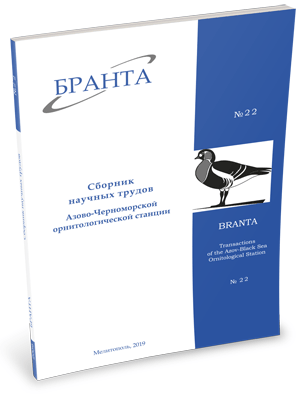
Transactions
of the Azov-Black Sea Ornithological Station



Current avifauna of mount Ak-Kaya on the Crimean Peninsula and its historical transformation
A. N. Tsvelykh 1, V. M. Kucherenko 2
2 – Taurida National V. I. Vernadsky University, Ukraine
The research of the sclerophyll avifauna of mount Ak-Kaya was conducted in May 2008, 2009 and 2019. 14 species were found: Tadorna ferruginea, Buteo rufinus, Neophron percnopterus (not breeding), Falco cherrug, Falco peregrinus, Falco tinnunculus, Columba livia, Apus apus, Apus melba, Upupa epops, Delichon urbica, Corvus monedula, Corvus corax, Oenanthe oenanthe. Comparing our results of 2008-2019 with the data collected by M. A. Voinstvensky in 1958 showed significant changing in the species composition of sclerophyll birds on Ak-Kaya. Neophron percnopterus, Athene noctua, Coracias garrulus, Monticola saxatilis and Oenanthe pleschanka did not nest in 2008-2019. Coracias garrulus was also not registered. This is an interesting fact, as this species nests in similar biotopes even in the immediate vicinity of Ak-Kaya.
The analysis of literary sources can determine the time of appearance of different species of birds in the species composition of Ak-Kaya avifauna. At the end of the XX century Falco peregrinus, Falco cherrug and Buteo rufinus started their nesting here. Tadorna ferruginea began to nest in the study area at the beginning of the XXI (possibly at the end of the XX) century, however, there is no evidence of the formation of a stable nesting population of this species. Currently, we have several registrations of Neophron percnopterus on Ak-Kaya. However, frequent registration of this species in the Crimea in recent years suggests the resumption of nesting of this species in the study area.
Read the paper in a PDF fileReferences:
- Grinchenko, A.B. (2009). Changes in the breeding avifauna of Anseriformes of the Crimea connected with anthropogenic succession of Sivash and steppe part of the peninsula. Branta: Transactions of the Azov–Black Sea Ornithological Station, 12, 59–69 [in Russian].
- Grinchenko, A.B., Kinda, V.V., Pilyuga, V.I., & Prokopenko, S.P. (2000). Modern status of Long-legged Buzzard in Ukraine. Branta: Transactions of the Azov–Black Sea Ornithological Station, 3, 13–26 [in Russian].
- Kostin, Yu.V. (1983). Birds of the Crimea. Moscow: Nauka [in Russian].
- Kostin, S.Yu., & Beskaravayny, M.M. (1999). New data on the Birds of the Crimea. In Fauna, ecology and conservation of Birds in the Azov-Black Sea region (pp. 23–26). Simferopol: SONAT [in Russian].
- Kucherenko, V M., Prokopenko, S.P., Zherebtsova, T.A., & Zherebtsov, D.Yu. (2017). Observations of rare bird species in the Crimea in 2013–2017. Berkut, 26 (1), 1–4 [In Ukrainian].
- Peklo, A.M. (1997). Catalogue of collections of the Zoological Museum, NSNHM, NAS of Ukraine. Birds, 2. Kiev: Zoological Museum NSNHM NAS of Ukraine [in Russian].
- Peklo, A.M. (2002). Catalogue of collections of the Zoological Museum, NSNHM, NAS of Ukraine. Birds, 3. Kiev: Zoological Museum NSNHM NAS of Ukraine [in Russian].
- Prokopenko, S.P. (1986). Saker in the Crimea. In Study of birds of USSR, their conservationand rational use, 2. (pp. 170–171). Leningrad: Zoological institute AS of USSR [in Russian].
- Tsvelykh A.N., Appak B.A., Beskaravainy M.M., Kostin S.Yu., & Osipova M.A. (2018). Vultures of the Ukrainian fauna. Kyiv: Fitosociocenter [in Russian].
- Voinstvensky, M.A. (2006). Diaries of the Crimean expeditions of 1957 and 1958. Avifauna of Ukraine, 3, 2–40 [in Russian].